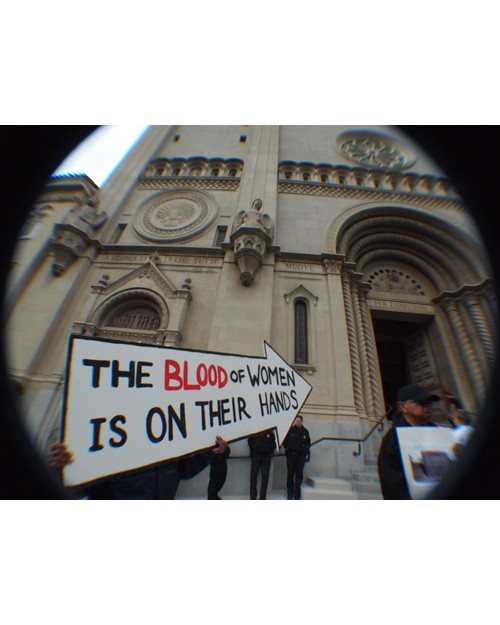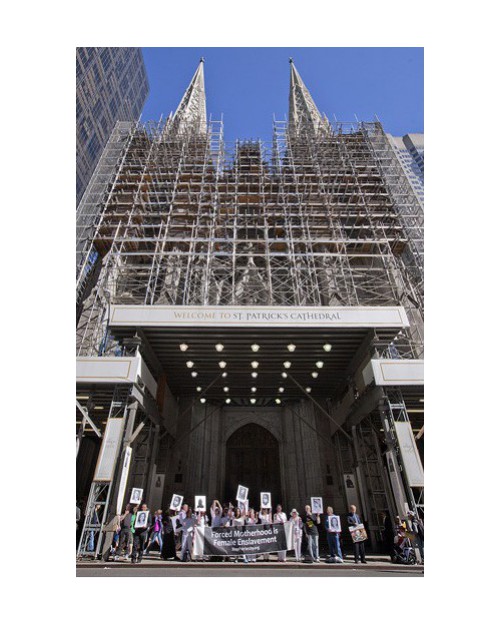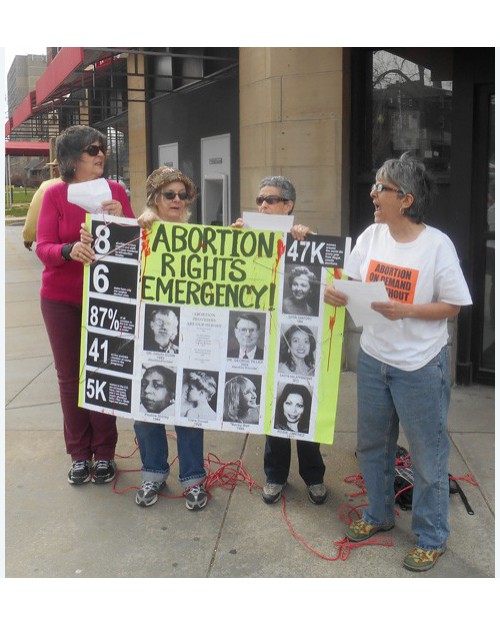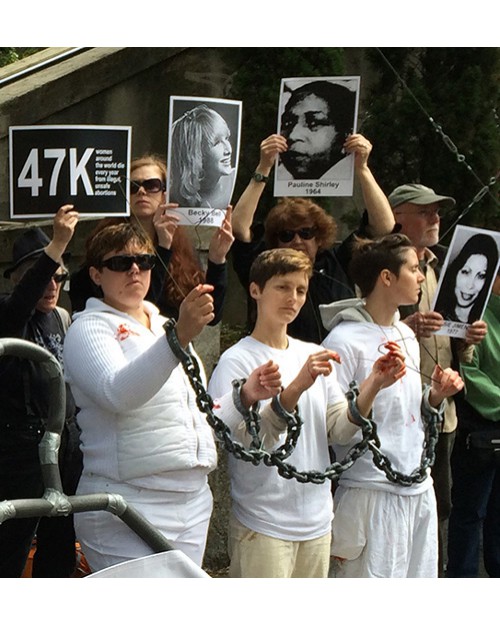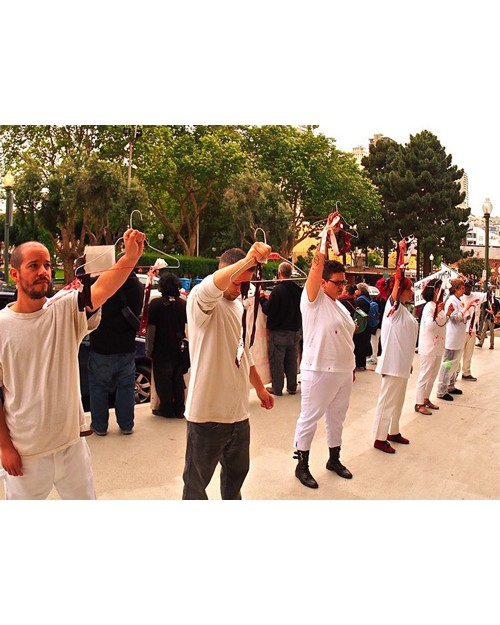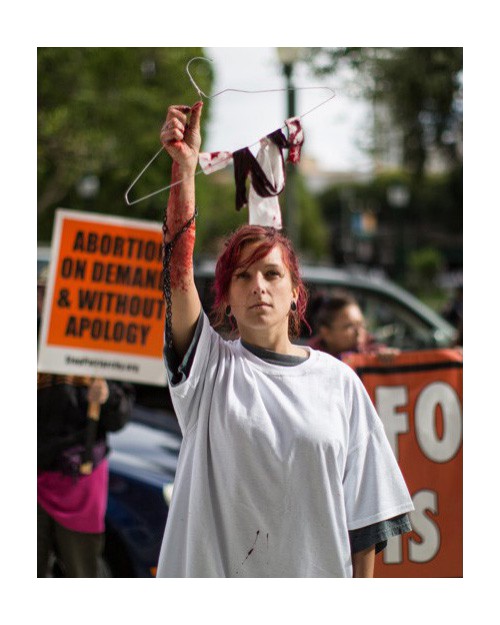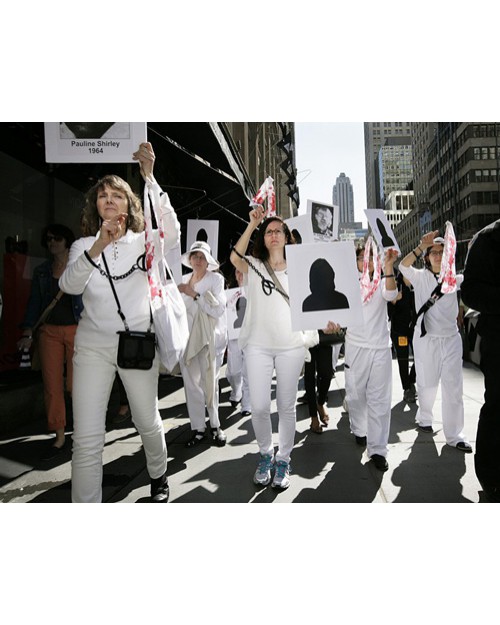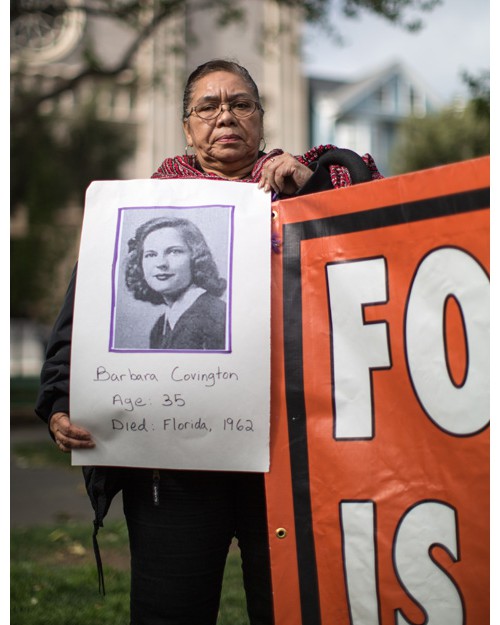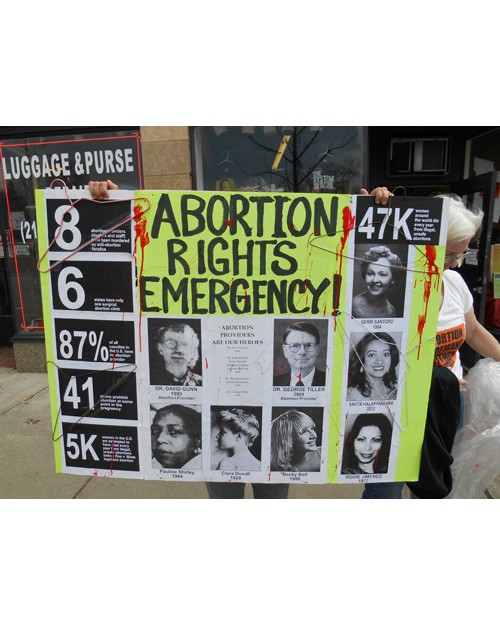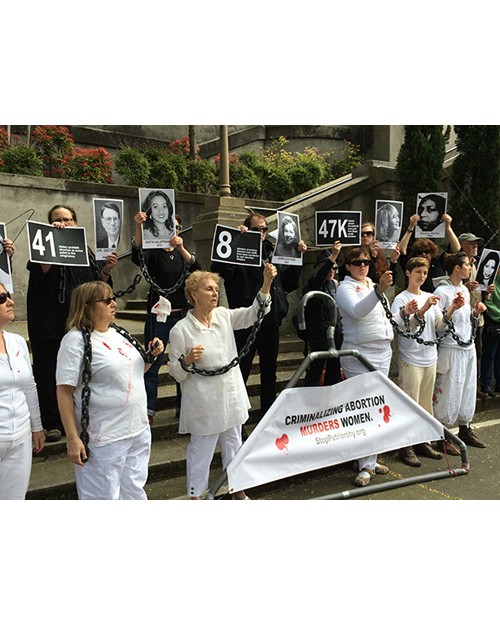April 11 & 12:
Powerful Actions to Respond to the Abortion Rights Emergency
April 21, 2014 | Revolution Newspaper | revcom.us
On April 11 and 12, hundreds took part in speak-outs and protests organized by the movement to End Pornography and Patriarchy: The Enslavement and Degradation of Women. In New York, San Francisco, Los Angeles, Seattle, and Cleveland, they responded to the intensifying abortion rights emergency. A total of hundreds more gathered in other places, including small towns and rural areas, to watch the webcast of the flagship speak-out in New York City.
The speak-outs on April 11 brought alive the stakes of the fight over abortion, sounded the alarm on the emergency, brought together inspiring and diverse voices about why they are dedicated to this fight, and brought alive a beginning vision of the kind of resistance and struggle it will take to win abortion on demand and to defeat the whole war on women.
The following day, April 12, dramatic and visually striking protests were held in front of Catholic churches and in crowded public areas which raised bloody coat-hangers and shackles, representing the enslavement and death of women when abortion is not available. Protesters who raised the coat-hangers wore all white. Behind them, protesters in all black raised pictures of the women who have died from illegal abortions and of the doctors who have been killed for providing abortions. After one hour of silent protest, people broke the silence, threw down the shackles and coat-hangers, and recited a Pledge to Resist which also called on others to join in taking this fight forward.
These events brought together the kinds of forces and the kinds of struggle needed on a far greater scale throughout society and provide both an example and a platform to spring forward from in creating this society-wide struggle.
New York City Flagship Speak-Out
“I had no idea.”
Over and over again, people who experienced the Abortion Rights speak-outs repeated the phrase, “I had no idea.” Stories about what women went through before abortion became legal, stories which have been buried for decades, stories which even back when they were excruciatingly common were almost never spoken of, were brought out in the light of day.
The evening opened with a powerful video from novelist and poet Marge Piercy speaking about how she nearly died from her own illegal abortion at age 18. “It was a time when falling in love could kill you,” she explained. Next, a video message from David Gunn, Jr. spoke of how his father, Dr. David Gunn, Sr., had been assassinated for providing abortions in the 1990s and his own deep commitment to defending abortion rights.
One woman told of how her best friend in high school bled to death in a parking lot alone, after going to Mexico to get an illegal abortion. Another recounted the white-cold terror she felt when, at age 20 back in the 1950s, she missed her period. She attempted to self-abort using a coat-hanger. At first, she didn’t think it worked and as the anxiety and shame mounted she contemplated suicide. A few days later, she woke in the middle of the night with blood gushing from her, her parents screaming, and an ambulance which took her to the emergency room. She is lucky she lived through it.
A third woman brought alive how little difference there is for poor and rural women today, where abortion requires hundreds of miles of travel and money they cannot scrape together, and the situation before the 1973 Roe v. Wade Supreme Court decision legalizing abortion. The final testimony came from a woman who found out she was pregnant at 17 and ended up going away to a home for unwed teenage mothers. She brought alive how wrong and harmful it was to be forced to have a child she did not want, how it was wrong and harmful that she and other women had not been allowed birth control or abortions. She also brought alive how much shame and secrecy hung over her and all the other women and girls in the home, one of whom was just 12 years old and still playing with dolls.
Actors read these testimonies with deep emotion, as well as excerpts from interviews or writings from three courageous abortion providers. Susan Cahill’s words brought alive the total devastation and hatred that was directed against not only her but all women in the destruction of her abortion clinic in Kalispell, Montana, on March 3 of this year. Susan Wicklund’s words shared her first day providing abortions as the main doctor in a new clinic, the tremendous relief her work brought to her patients, and her first realization of the incredible emotional and psychic harm done to her patients by the anti-abortion fanatics who protest outside most abortion clinics today. Susan Robinson’s words explained the conditions of women who come in for third-trimester abortions, how absolutely necessary these procedures are, and how the need for these procedures is often very intimately linked to the many links in the chain of women’s oppression (from abusive boyfriends, to extreme poverty, to shame and lack of sexual education especially for women, to pervasive rape and sexual assault, and more).
It took courage and strength for the women and the doctors to share these stories. Together, they conveyed a vivid and chilling sense of what life was like before Roe v. Wade: how sex carried the fear of having to give up your whole life, how death from botched abortion and forced motherhood touched women’s lives (whether directly or indirectly), and when the weight of all this was carried silently and under a mountain of shame. They also brought alive how abortion rights are far from “safe” today and gave a sense of the courage and commitment of the doctors who put their lives on the line to provide this service for women. The reality of StopPatriarchy’s slogans, “Forced Motherhood Is Female Enslavement,” and, “Abortion Providers Are Heroes,” came alive and the stakes of the fight over abortion rights became much more clear.
Diverse Voices, a Shared Commitment
Next, leaders in the struggle for abortion rights and courageous doctors and providers addressed the audience in person.
Dr. Willie Parker is an award-winning doctor who provides abortions at the last abortion clinic in Mississippi. He grew up in the Black Baptist church in the South with all the beliefs that go along with being a Protestant fundamentalist. Explaining how his beliefs changed through college and then even more when he began serving his female patients, he said, “When you wrestle with your conscience and you lose... you still win.” Most pivotal to him was a speech from Martin Luther King about the Good Samaritan Bible story; rather than asking what would happen to him if he stopped and helped the man on the side of the road, the Samaritan asked what would happen to the man if he did not stop and help. The question Dr. Parker began asking himself became, “What will happen to these women who come to me for help if I refuse to provide abortions for them?” Planting a pole of courage as well as a morality that places the interests of women above individual self-interest, he declared, “I could be concerned about me, but that would be concern with how I will die. I am more concerned with how I am going to live.”
Bill Baird, a pioneer in the fight for birth control and abortion, began with a story of working in Harlem Hospital back in 1963 and hearing a scream “unlike anything I’d ever heard.” A young Black woman was covered in blood from the waist down, with eight inches of a wire coat-hanger protruding from her vagina. She died in front of him and this launched him on a life-long mission to fight for women’s right to birth control and abortion. He was arrested eight times in five different states for lecturing on birth control and he took his case all the way to the Supreme Court where, in 1972, he won the right for unmarried women to access birth control. Audience members, especially younger ones, were shocked to learn this hidden history. It was not long ago when speaking publicly about birth control could land you in prison. Baird had risked 10 years in prison, and students and others joined in this fight, to change these laws.
Merle Hoffman is not only the CEO of Choices Women’s Medical Center, a clinic that has provided abortions to women for 43 years, she has also taken responsibility for waging the political battle that has raged around women’s right to abortion. Invoking the plans of Stop Patriarchy to protest the next day at St. Patrick’s Catholic Cathedral in New York City, she recounted how she had worked with Mary Lou Greenberg (one of the night’s emcees) and others to hold the first ever civil disobedience in favor of abortion rights almost exactly 25 years ago that night. She unapologetically told of her own abortion, why she has fought so hard for 43 years, and called for people to “occupy the abortion debate with the truth.” She ended with these words: “We must practice courage, and get ready for a deeper commitment: civil disobedience, getting arrested, whatever is necessary. We must provide support to [abortion] providers, because without providers there is no choice... We have to draw a line in the sand and hold it... hold it... and as my friend Flo Kennedy used to say, we’ve got to love the struggle.”
Sunsara Taylor, writer for Revolution newspaper and initiator of Stop Patriarchy, lifted people’s sights to a world without rape, a world without shame over women’s sexuality or restrictions on abortion, a world where women were liberated and humanity emancipated. She spoke of the need for a revolution rooted in Bob Avakian’s new synthesis of communism to realize this world. She spoke to the urgency of millions coming together from diverse perspectives to stand up right now to stop these attacks and envisioned an emergency response network that traveled to the site of every new attack, huge amounts of abortion rights fact sheets getting out on campuses and beyond, public protests and cultural expressions that change the way millions are thinking and draw them forward into action. She ended, “It is us who stand for the lives and future of women, and ultimately for the interests of humanity as a whole. We should hold our heads high and speak with conviction, get organized and stay connected, and find the ways for everyone—whether big or small, public or private, with your resources, your talents, your time, and/or your ideas—to contribute. Everyone can do something... together we can rise up and win a much better world.”
Taken together with a prayer delivered by Reverend Donna Schaper of Judson Memorial Church, as her contribution to the event, and a powerful reading by author and historian Louise Bernikow of a poem by Marge Piercy, these diverse voices brought alive a sense of urgency, a positive morality grounding this fight, and a beginning sense of how we can come together to start shifting the momentum of this war on women. It was clear that this will take sacrifice, but also clear that this sacrifice is worth it. And it was clear that this is a movement that not only welcomes but is strengthened by the different perspectives and approaches that people bring to this fight.
The evening culminated when actors and activists carried posters of the women who have died from illegal abortions and the doctors who have been murdered for providing abortions to the front of the room and everyone stood and read the Pledge to Resist together, sealing their commitment to spread and act on what they had heard.
Confronting the War on Women: Bloody Coat-Hangers and Female Enslavement
On Saturday, April 12, dramatic protests were held in New York, San Francisco, Seattle, Los Angeles, and Cleveland. In New York, San Francisco, and Seattle, these protests were held in front of Catholic institutions that bear responsibility for decades of spearheading the attacks on abortion and birth control.
Protesters wearing all white carried bloody coat-hangers, representing the way that many women used coat-hangers to self-induce abortions before Roe v. Wade and how this is what many women are being forced to do once again, even if this time they use other methods besides coat-hangers. Behind them, protesters dressed in all black carried the photos of women who died from illegal abortions and doctors who had been killed for providing abortions. Before Roe v. Wade, an estimated 5,000 women died each year from botched abortions. Currently, around the world an estimated 47,000 women die each year from this. Protesters also wore shackles representing the enslavement of women that is at stake if we do not stop this current war.
For a full hour, passerbys and parishioners stopped and stared at this striking visual tableau. Some were hostile, others very supportive, and a great many were intrigued, confused or shocked. Almost no one had thought about abortion in this context before. As one young woman who carried a picture of Rosie Jimenez (who died from an unsafe abortion in 1977) put it, “There is no way that you could walk by our protests and think this is about babies or about fetuses. We had these women’s faces—you could see their faces—and then a date that they died. This was clearly about women.” Expressing the sentiment of many of the protesters that day, she went on to say, “For me, holding that picture of Rosie that whole time, I just kept thinking about her life. She was a student, she had bills to pay, she had a kid already. Really, except that I was born at a different time, she could have been me. That just became really real to me. When I started agitating when I went across the street, I felt like I was screaming for Rosie and for her family.”
A young Latina who had been at one of the speak-outs the night before explained, “I am 24 years old and I have a two-year-old. I know how much work that is. It’s a lot of work. That’s what makes me strong in feeling that no one should ever be forced to do this unless they are 100 percent sure.” Another young woman responded, “For me, I am really chatty and so it is hard for me to be silent. Especially when people are being hostile, or when they are being really supportive. It was work to keep quiet. But it made me really have to think about the women. I mean, my back started hurting and I was getting hot and hungry, but I kept thinking about the women in the Rio Grande and what they are going through to get an abortion... or not get an abortion. It made me feel like it was a privilege to stand here in front of this huge church and speak for them.”
In New York City, in particular, where thousands of people stream down a busy street like Fifth Avenue in front of St. Patrick’s, hundreds of people stopped to snap pictures and nearly a thousand took fliers. These fliers described the overall emergency facing abortion rights, but also told the stories of the women whose faces were being held up. Groups of friends and sometimes families would stop and talk with each other about what they thought of the sight.
An older man confronted the protesters, “What is wrong with patriarchy? It is in the Bible. How can you be against patriarchy? It is in the Bible.” A woman yelled out over and over again, “You people are disgusting. What about the babies? You are going to hell. You are disgusting. You should be ashamed.” When her friend tried to take a picture of the tableau, she went a little crazy, yelling, “Don’t take their picture. Don’t give them any more attention! Don’t let anyone see this.” Another man walked slowly down the line of protesters, saying, “Murderer!” to each person’s face, one by one.
Others gave a thumbs up. Some women stopped to explain to their daughters what they were seeing. A man stood and watched for a full 10 minutes just taking the whole thing in, really feeling it, before signing up on the list to stay in touch with Stop Patriarchy. But, again, mostly people just took it all in; clearly this was a new thing for them to consider in this light.
Bill Baird, at age 81, stood with the same sign for birth control that he had held decades before and stayed shoulder to shoulder with these younger protesters.
After an hour, Sunsara Taylor led them all in breaking the silence and throwing down the shackles and coat-hangers. Their voices got louder and stronger as they joined together to recite the Pledge to Resist. As they did, a crowd of at least a hundred—possibly more—gathered on the steps of St. Patrick’s and the sidewalk to watch. When they finished, the protesters brought the pictures of the women and doctors up onto the steps of the cathedral themselves, bringing alive in one last way that the blood of women really is on the hands of that institution and that there is a determined and growing movement that will not stop until the war on women has been defeated.
Volunteers Needed... for revcom.us and Revolution
If you like this article, subscribe, donate to and sustain Revolution newspaper.

